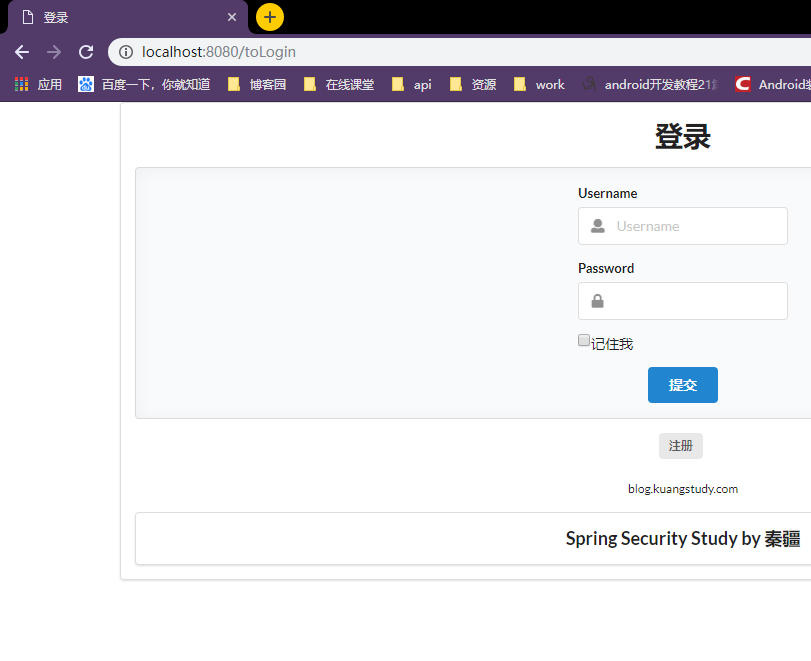springsecurity学习
首先讲一下,没有用到数据库,然后觉得重要的就是security的配置securityConfig.class,不太会说(好像也不太会用),上图吧,也是学习狂神过来的
项目结构

大致效果



pom.xml
<dependencies>
<!-- thymeleaf整合security -->
<dependency>
<groupId>org.thymeleaf.extras</groupId>
<artifactId>thymeleaf-extras-springsecurity5</artifactId>
<version>3.0.4.RELEASE</version>
</dependency> <!-- spring整合security -->
<dependency>
<groupId>org.springframework.boot</groupId>
<artifactId>spring-boot-starter-security</artifactId>
<version>2.1.4.RELEASE</version>
</dependency> <!--thymeleaf模板-->
<dependency>
<groupId>org.thymeleaf</groupId>
<artifactId>thymeleaf-spring5</artifactId>
</dependency>
<dependency>
<groupId>org.thymeleaf.extras</groupId>
<artifactId>thymeleaf-extras-java8time</artifactId>
</dependency> <dependency>
<groupId>org.springframework.boot</groupId>
<artifactId>spring-boot-starter-web</artifactId>
</dependency> <dependency>
<groupId>org.springframework.boot</groupId>
<artifactId>spring-boot-starter-test</artifactId>
<scope>test</scope>
<exclusions>
<exclusion>
<groupId>org.junit.vintage</groupId>
<artifactId>junit-vintage-engine</artifactId>
</exclusion>
</exclusions>
</dependency>
</dependencies>

重点来了SecurityConfig.class
@EnableWebSecurity
public class SecurityConfig extends WebSecurityConfigurerAdapter {
@Override //授权
protected void configure(HttpSecurity http) throws Exception {
//首页所有人都可以访问,但是功能页只有对应权限的人才能访问
//请求授权的规则
http.authorizeRequests()
.antMatchers("/").permitAll()
.antMatchers("/level1/**").hasRole("vip1")
.antMatchers("/level2/**").hasRole("vip2")
.antMatchers("/level3/**").hasRole("vip3"); /*
没有授权会自动跳转到登录页面 http://localhost:8080/login
定制登录页.loginPage("/toLogin") http://localhost:8080/toLogin
最后,走回 http://localhost:8080/login(因为要认证用户),页面的action动作为th:action="@{/login}"
其对应 http.formLogin().loginPage("/toLogin").loginProcessingUrl("/login")
*/
http.formLogin().loginPage("/toLogin").usernameParameter("name").passwordParameter("pwd").loginProcessingUrl("/login"); //防攻击网站工具
http.csrf().disable(); //关闭csrf功能,登出失败可能的原因 //注销 bug:注销完,应该跳到首页
http.logout().logoutSuccessUrl("/"); //开启记住我的功能,勾上才生效
http.rememberMe().rememberMeParameter("remember-me");
//http.rememberMe(); //cookie 来的,关闭浏览器还存在,默认时间两周
} @Override //认证
protected void configure(AuthenticationManagerBuilder auth) throws Exception {
//在内存中认证(因为没有连接数据库啊)
//密码编码 no PasswordEncoder mapped for the id "null"
//在spring security5+ 之后,新增了许多的加密方法
auth.inMemoryAuthentication().passwordEncoder(new BCryptPasswordEncoder())
.withUser("kuangshen").password(new BCryptPasswordEncoder().encode("123")).roles("vip2","vip3")
.and()
.withUser("root").password(new BCryptPasswordEncoder().encode("123")).roles("vip1","vip2","vip3")
.and()
.withUser("sajia").password(new BCryptPasswordEncoder().encode("123")).roles("vip1");
}
}
MyController.class
@Controller
public class MyController {
@RequestMapping({"/","/index"})
public String index(){
return "index";
}
@RequestMapping("/hello")
public String hello(){
return "hello springsecurity !";
} @RequestMapping("/toLogin")
public String toLogin(){
return "views/login";
} //9个页面
@RequestMapping("/level1/{id}")
public String level1(@PathVariable("id") String id){
return "views/level1/"+id;
} @RequestMapping("/level2/{id}")
public String level2(@PathVariable("id") String id){
return "/views/level2/"+id;
}
@RequestMapping("/level3/{id}")
public String level3(@PathVariable("id")String id){
return "/views/level3/"+id;
}
}
application.properties
#关闭模板引擎的缓存
spring.thymeleaf.cache=false
首页index.html
<!DOCTYPE html>
<html lang="en" xmlns:th="http://www.thymeleaf.org"
xmlns:sec="http://www.thymeleaf.org/thymeleaf-extras-springsecurity5">
<head>
<meta charset="UTF-8">
<meta name="viewport" content="width=device-width, initial-scale=1, maximum-scale=1">
<title>首页</title>
<!--semantic-ui-->
<link href="https://cdn.bootcss.com/semantic-ui/2.4.1/semantic.min.css" rel="stylesheet">
<link th:href="@{/qinjiang/css/qinstyle.css}" rel="stylesheet">
</head>
<body> <!--主容器-->
<div class="ui container"> <div class="ui segment" id="index-header-nav" th:fragment="nav-menu">
<div class="ui secondary menu">
<a class="item" th:href="@{/index}">首页</a> <!--登录注销--> <div class="right menu">
<!--未登录-->
<div sec:authorize="!isAuthenticated()">
<a class="item" th:href="@{/toLogin}">
<i class="address card icon"></i> 登录
</a>
</div> <!--登录了:显示注销,用户名-->
<div sec:authorize="isAuthenticated()">
<a class="item">
用户名:<span sec:authentication="name"></span> |
角 色:<span sec:authentication="principal.authorities"></span>
</a>
</div>
<div sec:authorize="isAuthenticated()">
<a class="item" th:href="@{/logout}">
<i class="sign-out icon"></i> 注销
</a>
</div> </div>
</div>
</div> <div class="ui segment" style="text-align: center">
<h3>Spring Security Study by 秦疆</h3>
</div> <div>
<br>
<div class="ui three column stackable grid">
<!--菜单的动态效果显示,根据用户的角色-->
<div class="column" sec:authorize="hasRole('vip1')">
<div class="ui raised segment">
<div class="ui">
<div class="content">
<h5 class="content">Level 1</h5>
<hr>
<div><a th:href="@{/level1/1}"><i class="bullhorn icon"></i> Level-1-1</a></div>
<div><a th:href="@{/level1/2}"><i class="bullhorn icon"></i> Level-1-2</a></div>
<div><a th:href="@{/level1/3}"><i class="bullhorn icon"></i> Level-1-3</a></div>
</div>
</div>
</div>
</div> <div class="column" sec:authorize="hasRole('vip2')">
<div class="ui raised segment">
<div class="ui">
<div class="content">
<h5 class="content">Level 2</h5>
<hr>
<div><a th:href="@{/level2/1}"><i class="bullhorn icon"></i> Level-2-1</a></div>
<div><a th:href="@{/level2/2}"><i class="bullhorn icon"></i> Level-2-2</a></div>
<div><a th:href="@{/level2/3}"><i class="bullhorn icon"></i> Level-2-3</a></div>
</div>
</div>
</div>
</div> <div class="column" sec:authorize="hasRole('vip3')">
<div class="ui raised segment">
<div class="ui">
<div class="content">
<h5 class="content">Level 3</h5>
<hr>
<div><a th:href="@{/level3/1}"><i class="bullhorn icon"></i> Level-3-1</a></div>
<div><a th:href="@{/level3/2}"><i class="bullhorn icon"></i> Level-3-2</a></div>
<div><a th:href="@{/level3/3}"><i class="bullhorn icon"></i> Level-3-3</a></div>
</div>
</div>
</div>
</div> </div>
</div> </div> <script th:src="@{/qinjiang/js/jquery-3.1.1.min.js}"></script>
<script th:src="@{/qinjiang/js/semantic.min.js}"></script> </body>
</html>
login.html
<!DOCTYPE html>
<html lang="en" xmlns:th="http://www.thymeleaf.org">
<head>
<meta charset="UTF-8">
<meta name="viewport" content="width=device-width, initial-scale=1, maximum-scale=1">
<title>登录</title>
<!--semantic-ui-->
<link href="https://cdn.bootcss.com/semantic-ui/2.4.1/semantic.min.css" rel="stylesheet">
</head>
<body> <!--主容器-->
<div class="ui container"> <div class="ui segment"> <div style="text-align: center">
<h1 class="header">登录</h1>
</div> <div class="ui placeholder segment">
<div class="ui column very relaxed stackable grid">
<div class="column">
<div class="ui form">
<form th:action="@{/login}" method="post">
<div class="field">
<label>Username</label>
<div class="ui left icon input">
<input type="text" placeholder="Username" name="name">
<i class="user icon"></i>
</div>
</div>
<div class="field">
<label>Password</label>
<div class="ui left icon input">
<input type="password" name="pwd">
<i class="lock icon"></i>
</div>
</div>
<!--记住我-->
<div class="field">
<input type="checkbox" id="remember-me" name="remember-me"/>记住我
</div>
<input type="submit" class="ui blue submit button"/>
</form>
</div>
</div>
</div>
</div> <div style="text-align: center">
<div class="ui label">
</i>注册
</div>
<br><br>
<small>blog.kuangstudy.com</small>
</div>
<div class="ui segment" style="text-align: center">
<h3>Spring Security Study by 秦疆</h3>
</div>
</div> </div> <script th:src="@{/qinjiang/js/jquery-3.1.1.min.js}"></script>
<script th:src="@{/qinjiang/js/semantic.min.js}"></script> </body>
</html>
剩下就是头疼的静态资源了
1.html(剩下八个都一样的,改下<h3>Level-1-1</h3>这个就好了)

<!DOCTYPE html>
<html lang="en" xmlns:th="http://www.thymeleaf.org">
<head>
<meta charset="UTF-8">
<meta name="viewport" content="width=device-width, initial-scale=1, maximum-scale=1">
<title>首页</title>
<!--semantic-ui-->
<link href="https://cdn.bootcss.com/semantic-ui/2.4.1/semantic.min.css" rel="stylesheet">
<link th:href="@{/qinjiang/css/qinstyle.css}" rel="stylesheet">
</head>
<body> <!--主容器-->
<div class="ui container"> <div th:replace="~{index::nav-menu}"></div> <div class="ui segment" style="text-align: center">
<h3>Level-1-1</h3>
</div> </div> <script th:src="@{/qinjiang/js/jquery-3.1.1.min.js}"></script>
<script th:src="@{/qinjiang/js/semantic.min.js}"></script> </body>
</html>
qinstyle.css
body{
min-width: 1150px;
overflow: auto;
}
#index-header-nav{
font-size: 0px;
}
#blog-lable>a{
margin: 1px;
}
剩下就是加油,多学多看多动手,加油
springsecurity学习的更多相关文章
- SpringSecurity学习之自定义过滤器
我们系统中的认证场景通常比较复杂,比如说用户被锁定无法登录,限制登录IP等.而SpringSecuriy最基本的是基于用户与密码的形式进行认证,由此可知它的一套验证规范根本无法满足业务需要,因此扩展势 ...
- SpringSecurity学习之基于数据库的用户认证
SpringSecurity给我们提供了一套最基本的认证方式,可是这种方式远远不能满足大多数系统的需求.不过好在SpringSecurity给我们预留了许多可扩展的接口给我们,我们可以基于这些接口实现 ...
- SpringSecurity学习之快速上手
互联网项目中,安全与权限控制是不可回避的问题,为了解决这一些列问题,许多安全框架应运而生了.这些框架旨在帮我们解决公用的安全问题,让我们的程序更加健壮,从而让程序员全身心投入到业务开发当中.那么Spr ...
- SpringSecurity学习四----------基于不同角色跳转到不同URL
© 版权声明:本文为博主原创文章,转载请注明出处 1.项目结构 2.pom.xml <project xmlns="http://maven.apache.org/POM/4.0.0& ...
- SpringSecurity学习三----------通过Security标签库简单显示视图
© 版权声明:本文为博主原创文章,转载请注明出处 1.项目结构 2.pom.xml <project xmlns="http://maven.apache.org/POM/4.0.0& ...
- SpringSecurity学习二----------实现自定义登录界面
© 版权声明:本文为博主原创文章,转载请注明出处 1.项目结构 2.pom.xml <project xmlns="http://maven.apache.org/POM/4.0.0& ...
- SpringSecurity学习一----------最简单的权限控制系统
© 版权声明:本文为博主原创文章,转载请注明出处 1.项目结构 2.pom.xml <project xmlns="http://maven.apache.org/POM/4.0.0& ...
- SpringSecurity学习笔记(一):搭建最简单的SpringSecurity应用
学习过程参考自:http://www.mossle.com/docs/auth/html/pt01-quickstart.html 一.搭建Maven项目: 所需引用的jar包如下: pom.xml文 ...
- SpringSecurity学习总结
第一.SpringSecurity-简介 1.1简介 SpringSecurity融合Spring技术栈,提供JavaEE应 用的整体安全解决方案: Spring Security为基于Java EE ...
随机推荐
- 通过Vagrant搭建PHP环境(一) Vagrant box添加配置
系统Windows10 Vagrant 1.8.1 VirtualBox 5.0.20 vagrant box下载地址:http://cloud.centos.org/centos/7/vagrant ...
- Linux学习:Makefile简介及模板
一.基本概念介绍: Makefile 文件就是告诉make命令需要怎么样的去编译和链接程序. 编写Makefile的基本规则: 1.如果这个工程没有编译过,那么我们的所有C文件都要编译并被链接. 2. ...
- python包中__init__.py文件的作用
python包中__init__.py文件的作用 __init__.py文件最常用的作用是标识一个文件夹是一个 python包. __init__.py文件的另一个作用是定义模糊导入时要导入的内容. ...
- haproxy配置文件实例
[root@kube-node1 ~]# cat /etc/haproxy/haproxy.cfg global log /dev/log local0 log /dev/log local1 not ...
- python中dict对象和字符串string对象互相转换
使用json包 import json dict1 = {"A":"a","B":"b"} # 转换为字符串 json. ...
- python遍历文件夹中所有文件夹和文件,os.walk
python中可以用os.walk来遍历某个文件夹中所有文件夹和文件. 例1: import os filePath = 'C:/Users/admin/Desktop/img' for dirpat ...
- IEEE754二进制浮点数算术标准
对于32位浮点数 sign: 符号,1位 exponent: 指数,8位,偏码 fraction: 分数,23位,原码 特殊值 指数域的编码值 = 指数的实际值 + 127 这样按照字典序的顺序就 ...
- Git常用命令速查表,新手必备版本控制
Git 跟 SVN 一样,都是用于管理代码的版本控制工具.无论在项目中,我们负责哪一块,只要需要编写代码,就必须熟悉Git(依公司要求而定). 当然,用的越熟练,处理的项目越顺利,离出任CTO.迎娶白 ...
- centos(linux)--vsftpd配置
1.安装 执行 yum -y install vsftpd 注:(1)是否使用sudo权限根据个人的具体情况 (2)rpm -qa | grep vsftpd 可以通过这个检查是否已经安装vsftpd ...
- zabbix案例实例
1 案例1:实现Zabbix报警功能 1.1 问题 沿用第5天Zabbix练习,使用Zabbix实现报警功能,实现以下目标: 监控Linux服务器系统账户 创建Media,设置邮件服务器及收件人邮箱 ...
